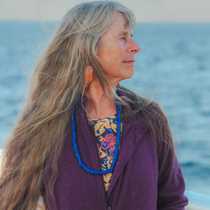Bahia Loreto Marine Park & Isla Danzante
Sunrise found the National Geographic Sea Bird heading north in the Bahia Loreto Marine Park. The sun rose just north of Isla Catalina, off the starboard side of the ship with Isla Monserrat slightly south and Isla del Carmen to the north. Our plans were to continue cruising in these rich waters throughout the first half of the day, searching for marine mammals. As the sun rose in the sky, spotters on the bow and bridge of the ship continued their search in the protected waters of this marine park. The morning sun decorated the Sierra de la Giganta, a magnificent display of rugged mountains running along the eastern side of the Baja peninsula. Large clouds of moisture coming from the western side of the peninsula draped like curtains over the mountains, creating a surreal scene and added humidity.
Breakfast was served on the National Geographic Sea Bird, giving everyone a chance to refuel before heading back out on deck to give more eyes to the search for marine mammals. As if on queue, a small pod of long-beaked common dolphins were spotted. The dolphins cruised by our small ship, but were not very interested and spent just a few moments checking out the noisy large vessel cruising their waters. Throughout the morning we wandered from the bow, to the top deck, and the forward lounge for a brief visit to the Global Market, then back to the bow.
The Sea Bird continued her passage in the waters of this well-known marine park, located in the southern end of the Gulf of California. This body of water is also called the Sea of Cortez, and the Vermillion Sea, and was created when the Baja peninsula split off from western Mexico several million years ago, leaving the tips of many of its volcanoes as a necklace of 53 islands scattered along the eastern side of the peninsula. In 1978 President López Portillo gave title to Isla Tiburon, Mexico’s largest island, and a section of the adjacent Sonoran coastline, to the Seri Indians. At the same time he created a series of biosphere reserves covering all the islands of the Gulf of California. These islands are an unusual environment and home to many rare birds, plants, animals and fish unique to this area of the world. This also gave rise to naming this grouping of islands the “Galápagos of the Northern Hemisphere.”
The rest of our morning was spent watching several small groups of dolphins, the changing sky rich in cloud patterns, and the light changing as the sun moved slowly across the sky. Lunch was announced and shortly after our expedition leader made her customary announcements about the remainder of our day. We were headed for our anchorage along the eastern side of Isla Danzante. This is one of the most rugged islands in the gulf, with 600 foot-high peaks that rise directly from the beach. The Sea Bird anchored off of Honeymoon Cove and began launching Zodiacs and kayaks for the afternoon activities. We were all invited to kayak, snorkel, enjoy a short but very scenic hike or just relax on the beach for the afternoon.
As the sun set over the tops of the Sierra de la Giganta, the hotel staff of the National Geographic Sea Bird was preparing a nearby beach for an evening barbecue. Transportation brought chairs, guests, staff and all the supplies for a delicious dinner ashore. A fire was lit, pizzas and fresh tuna, salad, ribs, baked bread and dessert all were supplied as we relaxed on shore watching the sky change from feathery clouds ever so slightly pale cream to flaming red and orange. Our Mexican staff member and host shared an old story from the ancient codices of Mexico as the stars filled the sky and a blanket of darkness replaced the brilliance of a sunny day, in this small but amazing corner of a unique ecosystem, affectionately called “a desert by the sea.”




